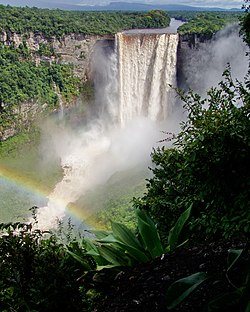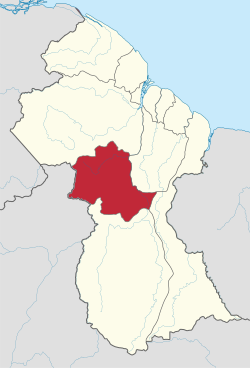Potaro-Siparuni
Potaro-Siparuni
Region 8 | |
|---|---|
Administrative Region | |
 | |
 Map of Guyana showing Potaro-Siparuni region | |
| Country | Claimed by |
| Regional Capital | Mahdia |
| Area | |
• Total | 20,051 km2 (7,742 sq mi) |
| Population (2012 census) | |
• Total | 10,190 |
| • Density | 0.51/km2 (1.3/sq mi) |
| [1] | |
Potaro-Siparuni (Region 8) is a region of Guyana. It borders the region of Cuyuni-Mazaruni to the north, the regions of Upper Demerara-Berbice and East Berbice-Corentyne to the east, the region of Upper Takutu-Upper Essequibo to the south and Brazil to the west.
The main villages in the region are Campbelltown, Orinduik, Mahdia, Paramakatoi and Tumatumari.
Population
[edit]The Government of Guyana has administered three official censuses since the 1980 administrative reforms, in 1980, 1991 and 2002.[2] In 2012, the population of Potaro-Siparuni was recorded at 10,190 people.[3] Official census records for the population of Potaro-Siparuni are as follows:

- 2012 : 10,190
- 2002 : 10,095
- 1991 : 5,616
- 1980 : 4,485
Communities
[edit](including name variants):[4]
- Arnik Village
- Campbelltown
- Itabac
- Kamana Village
- Kanapang Village
- Kato (Kato Village, Karto)
- Kopinang Mission
- Mahdia
- Micobie
- Monkey Mountain
- Orinduik
- Paramakatoi (Paramahatoi)
- Potaro Landing
- Taruka
- Tumatumari
- Tumatumari Landing
- Waipa Village
Tourism
[edit]Kaieteur Falls is a major tourist attraction in Guyana. It is in Kaieteur National Park in the center of Guyana's rainforest. The park is served by Kaieteur International Airport, about a 15-minute walk from the top of Kaieteur falls, with frequent flights to Ogle Airport and Cheddi Jagan International Airport in Georgetown. Within Potaro-Siparuni is also a section of the Amazon rainforest.
Territorial claim
[edit]Venezuela has attempted to renew its claim to Guyana’s Essequibo territory, which is situated west of the Essequibo river. The status of the border controversy is subject to the Geneva Agreement, which was signed by the United Kingdom, Venezuela and British Guiana on February 17, 1966. As of December 2020, the matter is being addressed by the ICJ.[5]
Pending its final decision, the ICJ indicated the following provisional measures in its Order of 1 December 2023:[6]
(1) The Bolivarian Republic of Venezuela shall refrain from taking any action which would modify the situation that currently prevails in the territory in dispute, whereby the Co-operative Republic of Guyana administers and exercises control over that area;
(2) Both Parties shall refrain from any action which might aggravate or extend the dispute before the Court or make it more difficult to resolve.”
See also
[edit]References
[edit]- ^ Macmillan Publishers (2009). "Administrative Regions - 8, 9 and 10". Macmillan Junior Atlas: Guyana. Oxford: Macmillan Caribbean. p. 37. ISBN 9780333934173.
- ^ Beaie, Sonkarley Tiatun (19 September 2007). "Chapter 3: National Redistribution and Internal Migration" (PDF). 2002 Population and Housing Census - Guyana National Report. Bureau of Statistics. p. 51. Archived from the original (PDF) on 24 November 2007. Retrieved 29 August 2012.
- ^ Beaie, Sonkarley Tiatun (19 September 2007). "National Population Trends: Size, Growth and Distribution" (PDF Download). 2002 Population and Housing Census - Guyana National Report. Bureau of Statistics. p. 25. Retrieved 29 August 2012.
- ^ "2012 Population by Village". Statistics Guyana. Retrieved 8 December 2021.
- ^ Summary of the Judgement of 18 December 2020
- ^ https://www.icj-cij.org/sites/default/files/case-related/171/171-20231201-sum-01-00-en.pdf [1]

